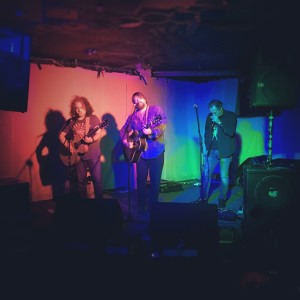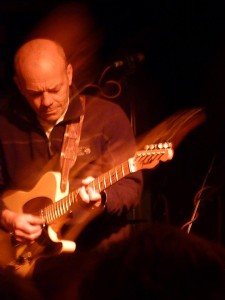
Slammin’ and Jammin’ in London (with audio)
I was in London earlier this week, and I had two opportunities to perform: once with Lowlands at the Windmill in Brixton, and once at the Tuesday night jam session run by Dov Jones at the Spice of Life in Soho. Both performances had their own unique opportunities and obstacles, and both were ultimately very satisfying experiences.
Playing The Windmill with Lowlands: Fun, not without tribulations

The gig at the Windmill on March 6 was a full-set performance. Ed Abbiati (the leader) on acoustic guitar and vocals and Robert Diana on slide acoustic guitar and vocals were in excellent form for this show, and I had a fine night too. I had the opportunity for a sound check, and I was able to set up my Digitech RP360XP with Fireball mic, running a 1/4″ cable from the RP to a direct box that went to the board. This is of course my preferred setup for a gig, and on this night it performed brilliantly.
The last time I played the Windmill, the sound tech ran a single XLR cable from the left XLR output on my RP355; as I learned later, there’s no such thing as a mono XLR out on the RP355, so exactly half the signal went to the board that night, which was far from good. The much better solution with any RP is the one I used at the Windmill this time around.
So my rig was set up to my specifications, and it sounded great on a wide range of sounds, including rotary speaker tones, a slide guitar setup that uses the Whammy effect to shift chords up and down, a tenor sax sound, and a very clean tone with a little room reverb. So what’s the obstacle, you say? Well. Since my last trip to the Windmill, they’ve replaced their analog PA console with a digital console, and on the night of this performance, the soundman cheerfully advised us that he did not know how to use the board. He didn’t know where a mono audio output could be found, so we had problems setting up my Zoom H4 to record the show. (Ed Abbiati, the band’s leader, brought a backup device, and we managed to get a recording off that.) Even worse, the sound tech somehow managed to stick an inappropriately deep, long reverb on the vocal mic, and that produced a cloudy haze in the low-midrange frequencies that lasted throughout the set.
Not tops.
That aside, I really did like my and the band’s sounds that night, and I’ve included the live recording of Ed’s song “38th and Lawton”, one of the first pieces I ever recorded with him, so you can hear some of what I heard on the gig. For this song I set the RP360XP to the DIRROOM patch that’s included in my latest (v18) patch set for the Digitech RP360XP, and I played a Hohner Special 20 in low E tuning in first position; this is in fact the very same harp that I used to record the original version with Ed for the first Lowlands Album, seven or eight years ago. The tones I got with the Fireball and the RP on this piece range from traditional harp sounds to accordian, organ, and horn sounds. Feelings of peace and joy suffuse the piece, and certainly the harp part.
It’s a damn nice song, and I only wish the sound tech had known a little more about that console. Dig.
Lowlands “38th and Lawton” performed live at the Windmill, Brixton, UK, Mar 6 2016
Audio Player
Spice of Life:Experienced Jammers
So that was Sunday night. I was too wiped out Monday night to go out, so I missed the Monday night jam at Ain’t Nothin’ But the Blues. Instead, I went out Tuesday night to the Spice of Life to check out the blues jam there, which I’d never attended before. It turned out to be a good night to go, because the leader of the jam, Dov Jones, told me that the club is dropping its 7-nights music format soon in order to concentrate on the higher-margin business of corporate parties. Glad I made it to the show before it all comes to an end.
This is what the audience sees at the Spice of Life, minus all the people…

I went to the club early to get some dinner and listen to Jones’s band rehearse, which was a pleasant experience. If a crew is worth playing with, they’re worth listening to, and Jones’s music is a unique blend of rock with jazz chords and blues sensibility. Fun stuff. I put my name on the signup sheet and waited for the jam to start.
It was interesting to see the jammers show up. Blues was the dominant music of the 20th century, not the 21st (at least not so far), and most of the musicians present were definitely from the 20th century, overwhelmingly male and in their 50s-60s, supplemented by a smaller contingent of players in their 20s-40s. (One of Jones’s guitarists looked like he might still have been in his teens, but he was pretty much the lone representative of that cohort.) The vast majority of jammers brought guitars, with a few bass players, a saxophonist, and a handful of drummers in the mix–and me with my harps, of course.
The good thing about being over 50 is that if you’ve been playing since your 20s, you’re way past the 10,000 hours that you need to put into your instrument to qualify as an expert, and the players at that jam knew their instruments well. I had a good time listening to a number of blues standards, and to players like Johnny Carroll, who I’ve met and played with a few times.

After about an hour, the guy who’d played excellent lap steel in Dov’s band got up to play harp. He used what looked like a Hohner 365–one of the extended-range Marine Bands that Sonny Boy Williamson favored, with a red comb–and he played straight through a vocal mic (a Shure SM58, I think) into the PA. That’s not my favorite setup for blues, and I didn’t much like the sound of it listening to him. It turned out to be the only setup available when I got up to play, because I didn’t have time to get the RP360XP up and running with a line into the PA. At least I was able to unwrap the mic cable from the stand so I could cup the SM58 comfortably.
Saved by the Key
Fortunately, the guitarist leading the tune called a medium shuffle blues in C, which meant that I could use an F harp (the Manji I carry in my road kit) in second position. That’s close to ideal for a harp into a vocal mic, because high-pitched harps let you project farther and tougher with less effort than the low-pitched ones. It’s not easy to play a low-pitched harp with a tough, punchy tone, because those low-pitched reeds don’t respond quickly or cheerfully to high levels of air pressure. That’s why amped setups are SO important to working with styles like Chicago blues, where you need lots of punch in the harp no matter what key you’re in to get the rhythmic message across. (A slow attack on big notes works okay for ballads, not so much for medium and uptempo blues.)
Anyway, I was certainly loud enough to hear myself clearly, which is more than half the battle, and I stopped worrying about my sound after about the first 8 bars of the tune. I got a lot of space in the tune to work the harp, and I was able to bring a few different roles to bear–harp, horn section, organ–even without the ideal sounds to go with the roles. (Well, hand or throat vibrato can be applied to make organ sounds, sort of, and if you use octaves and chords in the right way, it’s sorta horn-ish. The impersonation is a more convincing with a few FX, like a pitch shifter, rotary speaker, vibrato… it’s the difference between a reference and the thing itself.) With the first role I tend to use more-traditional licks and sounds for a starting point; for the latter two, I concentrate on texture and rhythm to add weight and punch to the sound of the band. It all worked.
The thrill ain’t gone
The second tune up was “The Thrill is Gone” in B minor, and this was a little more complicated. The ideal harp for this tune in my opinion is a Natural Minor in 2nd position. Unfortunately, I didn’t have a B Natural Minor in my kit that night. I could have gone with a G harp in 5th position, which like 2nd position on a Natural Minor delivers an Aeolian mode, but 5th position on a G harp into a vocal mic isn’t tops–lots of low notes that don’t respond all that quickly under pressure, a lot of work to get the desired effect. I ended up using a Seydel Session Steel A harp in 3rd position, overblowing the 6 reed up and bending the draw 3 reed down to get the flatted 6th degree of the scale that’s so important in this tune.
Both tunes went down with the audience very well, and I had a good time playing them. After I finished, the lap steel/harp player asked me what rig I was using on those tunes. I told him that it was the same as the one he used. He was surprised. There’s a tendency among a lot of casual harp players to think that it’s the gear that makes the sound, but the fact is that it’s the player, not the gear, that makes a tone big, and a big tone sounds good no matter what kind of gear you put it through. Of course the gear lets you create a wider range of sounds and emotions, and who doesn’t like that? I sure do. But in the end, if you can’t make your message heard with nothing more than a harp, you’ve got some work to do.
It’s always fun to check out the scene in London, and I’ll look forward to my next trip.
Tags In
Related Posts
Leave a Reply
You must be logged in to post a comment.
WHAT’S NEW
Categories
- Audio/Video
- Blog
- Blue Future
- Digitech RP Tricks and Tips
- Discography, CDs, Projects, Info, Notes
- Featured Video
- For the Beginner
- Gallery
- Hunter's Effects
- Hunter's Music
- Huntersounds for Fender Mustang
- Meet the Pros
- More Video
- MPH: Maw/Preston/Hunter
- My Three Big Contributions
- Player's Resources
- Pro Tips & Techniques
- Recommended Artists & Recordings
- Recommended Gear
- Recorded Performances
- Reviews, Interviews, Testimonials
- The Lucky One
- Uncategorized
- Upcoming Performances
- Zoom G3 Tips and Tricks